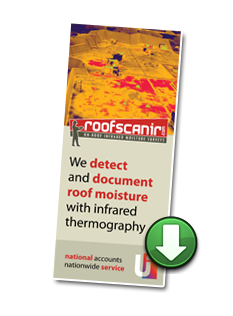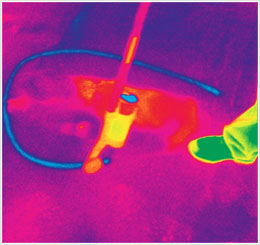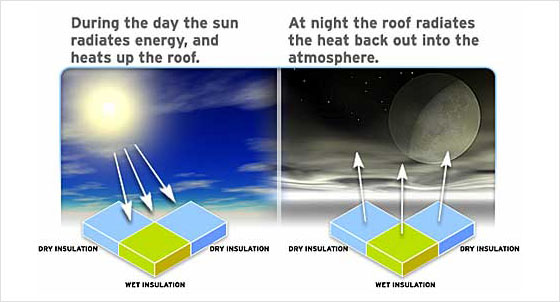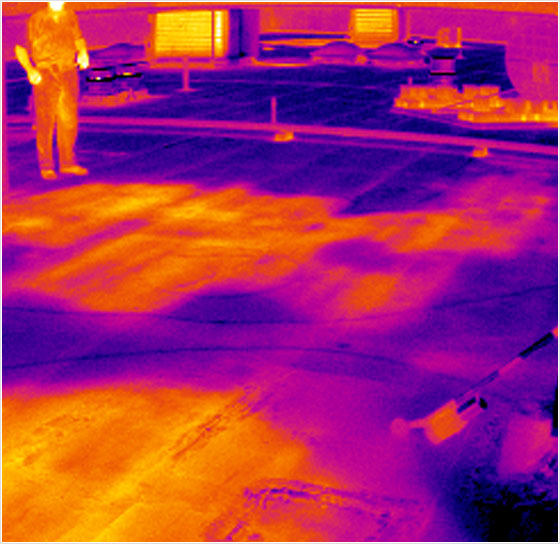Webinar on Infrared Roof Surveys
- View the Webinar above for detailed info about RoofScanIR™
- Online Training now available. Click Here and get started today!
- How ChevronTexaco saved $5.6 million by employing infrared thermography on roofs: Technology@Work: Infrared Imaging
- Up, Up and Away: An article by Greg Stockton about Aerial Infrared SurveysUp, Up and Away: Up Time Magazine
- Press Release: RoofScanIR™ Launch Press Release
- Press Release: RoofScanIR™ Technical Director Appointment

How we can help you maintain your flat and low-sloped roofs…
Infrared imaging is a proven method for identifying and defining moisture problems in your roof. This enables you to make informed decisions and will help develop your roof asset management program. Correct problem areas without the tremendous expense of replacing the entire roof.
As water enters your roof through the waterproofing layer(s) by tears, cuts, poorly sealed penetrations, failed flashings and caps, the insulation below can become laden with water and trapped in the roof substrate. If left in disrepair, the concrete deck absorbs or traps water, the wood deck rots. The metal deck rusts, and water intrudes into the building’s interior. Infrared thermography is useful in locating these moisture intrusions.

Roof Maintenance in General
Waterproofing problems manifest themselves in two ways: leakage and entrained moisture contamination.
Leakage is pretty simple, although the leak inside the building rarely directly relates to the exact spot on the roof because the water flows down the slope of the roof to a spot that is not sealed and into the building at that point. Most leaks occur where the waterproofing termination is sealed or where there is a penetration of the roof. Since most types of roofing systems absorb some amount of water, it is harder to find the exact spot of water contamination in the insulation because it may not leak into the building until the insulation has absorbed all the water it can hold.
There are three types of surveys that are used to find water in a roof. Nuclear gauges - which count neutrons, capacitance meters - which measure resistance, and infrared - which measures heat. Both nuclear gauges and capacitance meters are used to take spot readings on a 5’ X 5’, 10' X 10' or 20' X 20' grid on the roof. These measurements are used to extrapolate where the water is from the readings obtained from the gauges. These surveys are very labor-intensive and therefore expensive. They are good for types of roofs that do not gain or lose much solar energy and therefore, do not lend themselves to infrared.
With the average lifespan of the typical commercial or industrial roof being seven years, regular inspections and a proper roof maintenance program are required if the owner wishes to properly maintain the roof. The lifespan can be increased by as much as 300%, resulting in significant savings for the roof owner.
Why use Infrared Thermography on Flat Roofs
By using infrared thermography, we find the trapped moisture and mark the wet areas so that repairs can be made surgically. This can save you money because you may not have to replace the roof as soon. By marking paint directly on the roof, repair areas can be seen by anyone standing on the roofs after the survey is performed.
How it works…
During the day, the sun radiates energy onto the roof and into the roof substrate, and then at night, the roof radiates the heat back into outer space. This is called radiational cooling. Areas of the roof that are of a higher mass (wet) retain this heat longer than that of the lower mass (dry) areas. Infrared imagers can detect this heat and "see" the warmer, higher mass areas, during the "window" of uneven heat dissipation. Heat loss and other IR services can be performed at the same time.
By using the information generated by a RoofScanIR™ report, the owner’s roofing professional can recommend cost-effective removal and replacement of wet components and draw documents to prepare an adequate roofing substrate to receive a recover installation to extend the satisfactory roofing system’s service life.

Why RoofScanIR™?
We create detailed, high-quality, and easy-to-understand reports documenting roof moisture. Roof professionals can then use the information to verify the wet areas and write specifications to repair the roof.

